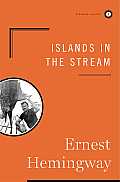 Islands in the Stream was published after Hemingway’s suicide in 1961and has never achieved the status of his most famous works. I don’t know how to account for such things, but I found this a novel of extraordinary depth and scope despite its rather focused concentration on the protagonist.
Islands in the Stream was published after Hemingway’s suicide in 1961and has never achieved the status of his most famous works. I don’t know how to account for such things, but I found this a novel of extraordinary depth and scope despite its rather focused concentration on the protagonist.
I’m assuming the title refers to the book’s structure, which gives us three episodes in the life–islands in the river of life?–of painter Thomas Hudson. We meet him as a successful artist living in Bimini and enjoying a visit from his sons by two different wives, neither of which any longer lives with him. He’s a disciplined worker, despite his penchant for sex-and-alcohol-fueled soirees and his choice of philandering buddies. Then, as in the life of all novels, things change.

The first change is death. Three of his sons and their mother die in a car accident near Paris. We, like Hudson, only hear of the deaths, and we participate in his grief long distance. He seems almost incapable of facing it head on, using booze and sex as a refuge. Throughout it all, Hemingway establishes him as an accomplished sailor, a rather magnetic man who has gathered a following of minions who are glad to serve him in various capacities. They are loyal beyond his money. Real devotion.
There are sputters here and there. A very close friend, Roger, whom we think in the first book will be a main character, disappears after the first book. I missed him. I’m sure I was supposed to. as we all miss people who drift out of our lives no matter how close we felt to them at one time or another.
Then comes WWII and the death of the fourth son–a pilot. An attempted reunion with this mother. More booze and sex. Thus endeth–more or less–the second book.
Finally, we leapfrog till later in the war when Hudson and his near-to-Cuba sailing crew discover the homes of friends burned and their bodies murdered, apparently, by the renegade crew from a German submarine. The chase is on through a myriad of keys. I know next to nothing about sailing, but you’ve got to believe the authenticity of Hemingway’s detailed accounts of navigation. Even if he makes mistakes, the writing has such authority, there’s no choice but to accept it.
Hemingway chooses to spend much of his time inside Thomas Hudson’s mind, and he breaks some of the nice MFA rules about show and tell without breaking a sweat. He presents him as a man with some, though not great, insight into himself or his situation. And, most attractively, views himself utterly without self-pity despite the disasters life has visited upon him. Perhaps this sums up Hudson’s conclusions about it all:
The horrors were what you won in that big crap game that they run. You put it on the line and made your point and let it ride . . .
If that’s a more or less autobiographical statement, E.H. let it ride right up till he picked up that shotgun in Ketchum, Idaho. It’s a shame it all had to stop so soon, but I’m glad he left his behind for us.
